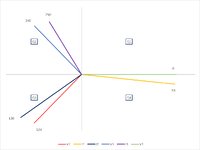Can someone provide step by step instructions for how to make a Phasor (Quadrant) diagram (chart) like the screen shot below? This is 360° chart, that should rotate counterclockwise. V1 will always be at 0°.
Here is the data for the attached chart:
V1=0°
I1=10°
V2=120
I2=130°
V3=240°
I3=250°

Here is the data for the attached chart:
V1=0°
I1=10°
V2=120
I2=130°
V3=240°
I3=250°






